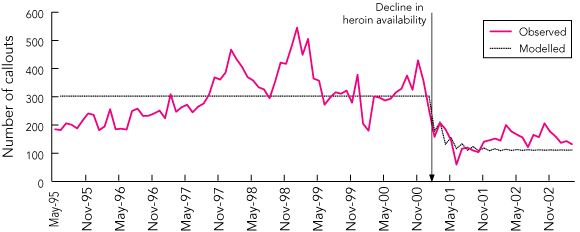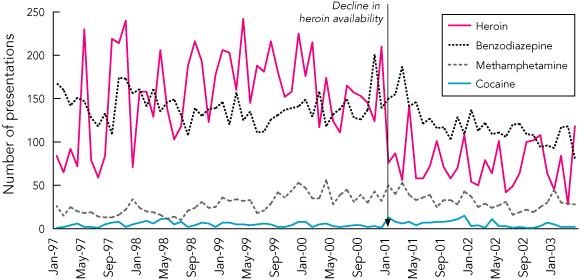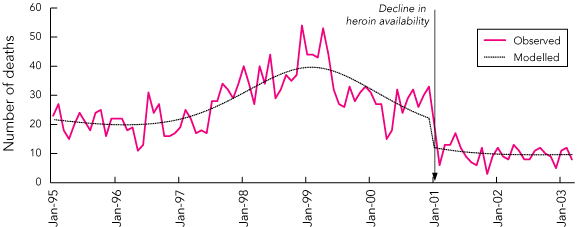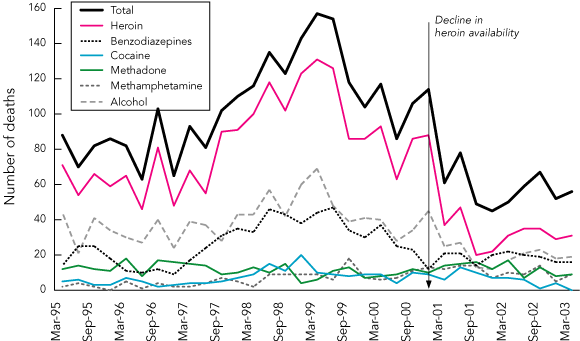The harm that heroin use causes its users and the community is disproportionate to the relatively low prevalence of its use in most developed countries.1 One of the most common harms is heroin overdose, both fatal and non-fatal.2 Research has suggested that many heroin-related deaths are polydrug deaths,3 and it may be that the combinations of drugs involved in drug-related deaths change over time.4
During the 1990s, there was a substantial increase in the scale of Australian heroin markets. In New South Wales during 1993–1999, the price per gram of heroin reached a historic low, the purity of street heroin was 60%, and heroin was the most commonly injected drug among regular injecting drug users (IDUs).5 In the late 1990s, there were substantial rises in the number of people being treated for heroin dependence, in deaths related to heroin overdose, arrests related to heroin, and in hepatitis C infections.6-8
Heroin overdose deaths became an issue of great public concern around the country in 1997.9 In response, new harm-reduction initiatives were implemented in the late 1990s. In NSW, information about reducing the risk of overdose was distributed, NSW police made it standard policy not to accompany ambulance officers when they attended drug overdoses to reduce the fear of police apprehension among illicit drug users, and there were increases in the provision of opioid replacement therapies. Despite these efforts to reduce harm and demand, overdoses continued to increase.
In early 2001, a dramatic decline in the availability of heroin in Sydney was reported by injecting drug users, law enforcement personnel working in key drug markets across the city, and by those working in treatment agencies targeting heroin users.10,11 These initial reports were confirmed across the country by the 2001 Illicit Drug Reporting System (IDRS), Australia’s strategic early warning system,12 and examined in the United Nations report Global illicit drug trends.13 In NSW, the purity of heroin available on the street fell from 60% to around 25%–30%, availability decreased significantly, and the price of a “cap” of heroin doubled from $25 to $50.14 The reduction in availability was most severe from January to April 2001, but the heroin supply still does not appear to have returned to the levels seen in the late 1990s, with the maintenance of lower purity levels and higher prices.14 Following the onset of the shortage, regular IDUs reported less frequent heroin use, and increases in cocaine, methamphetamine and possibly benzodiazepine use were reported.15,16
Our aims were therefore to examine whether, after the reduction in heroin supply in Australia in 2000–2001, there was any change in:
the number of non-fatal and fatal heroin overdoses;
the number of cocaine, methamphetamine and benzodiazepine overdoses; and
the drug combinations involved in deaths among “suspected drug takers” referred to the NSW Coroner for investigation.
This project was approved by the University of New South Wales Human Research Ethics Committee (HREC), the South East Sydney Area Health Service HREC, the South West Sydney Area Health Service HREC, the Central Sydney Area Health Service HREC and the Aboriginal Health and Medical Research Council Ethics Committee.
Data from emergency departments in NSW are collected centrally in NSW Health’s Emergency Department Information System (EDIS), and data were obtained from NSW Health on overdoses between 1 January 1997 and 30 June 2003. Diagnostic information on people presenting to the emergency departments (ED) of NSW hospitals is coded using the International classification of diseases, 9th revision (ICD-9).17 This information is recorded at the time of presentation to the ED. The following ICD-9 code groups were used to examine overdose of different drug types: (i) heroin — 965, 965.01, E850.0; (ii) methamphetamine — 969.7, E854.2; (iii) cocaine — 968.5; (iv) benzodiazepines — 969.4.
The data were analysed using an ARIMA (autoregressive integrated moving-average)-model time series with intervention terms.18 Analyses showed that the intervention-model time series was not appropriate for some series. Natural spline smoothers with serially dependent residuals were fitted to these series to test the impact of the heroin shortage as a step or a pulse term. The intervention terms were linear and could be interpreted as for a standard linear model. Several models were tested with different numbers and types of basis points, and standard methods of model selection (generalised cross-validation, significance of terms, and low prediction variance) were used to select the best-fitting model. Model fitting for these types of smoothers is described elsewhere.19 Linear models were fitted using S-Plus 6.1.20
The number of non-fatal heroin overdoses decreased substantially, whether measured by ambulance callouts or ED admissions. Box 1 shows the observed and modelled number of ambulance callouts to suspected heroin overdoses between 1995 and 2003. After adjusting for serial dependence, there was a 40% decrease (P = 0.009) after the reduction in heroin supply, which decayed over time to a final stable mean of 111.6 callouts per month (from an initial mean of 302.7 callouts per month). This represented an overall decrease of 63% (P = 0.02). There was a similar statistically significant 40% decline in the number of ED presentations for heroin overdose (Box 2).
In contrast to the strong effect observed for heroin overdoses, there was no significant change in methamphetamine or benzodiazepine overdose associated with the reduction in heroin supply (Box 2). This did not differ between sex or age groups.
There was an apparent increase in cocaine overdose presentations to EDs across NSW at the time of the shortage (Box 2). This increase applied to both males and females, and to all age groups, except the older age group of 45 years and over. However, because of the very small numbers, statistical analyses were not possible.
Data on suspected drug-related deaths between January 1995 and June 2003 showed a 43% decrease (P < 0.0001) in the number of drug-related deaths after the reduction in the supply of heroin (see Box 3).
Most of the steep drop was the result of a change in the number of deaths where heroin was involved (Box 4). After the reduction in heroin supply, there was a decrease in the number of deaths in which heroin was detected, and a corresponding decrease in the total number of deaths among suspected drug takers in NSW. Deaths involving alcohol and benzodiazepines decreased along with the shifts in the number of heroin-related deaths (Box 4). In contrast, deaths involving cocaine, methadone, methamphetamine and antidepressants remained stable.
The decline in deaths was similar for males and females. Among males, the number of deaths decreased from around 25 per month immediately before the heroin shortage to around 10 per month after the onset of the shortage. Among females, the number of deaths decreased from around five to seven per month to around two per month. These lower levels appear to have been maintained since then.
There were marked age differences in the trends in deaths where heroin was detected. There was a 65% decrease in heroin-related deaths among those aged 15–24 years (P < 0.0001), a 39% decrease in those aged 25–34 years (P = 0.01) and a 42% decrease in those aged 35–44 years (P = 0.008). A test of a model that included an interaction term between age and the decline in deaths (details available from the authors) indicated that there was no significant decrease in heroin-related deaths among people aged over 45.
Analyses of drug combinations detected among DAL cases (results not shown) showed that the proportion of all such deaths in which heroin was detected decreased from about 90% to 70%–75% after the onset of the heroin shortage. The proportion of deaths in which only heroin was detected decreased from around 25% to 10%. In contrast, the proportion of drug-related deaths where heroin was detected along with a range of other depressant drugs (methadone, alcohol, benzodiazepines, or other opioids) increased from around 10% of cases in December 2000 to 25% in December 2001. This was consistent with reports from injecting drug users suggesting increased polydrug use after the reduction in heroin supply.
In early 2001 there was a large and persistent decrease in the number of non-fatal heroin overdoses and a significant and sustained decrease in the number of deaths where heroin was detected in the deceased. Decreases in heroin overdoses were of a similar magnitude for men and women, but there were bigger decreases among younger age groups and no detectable change among those aged 45 years and older. It is possible that a reduction in heroin availability had a bigger impact on younger than older heroin users’ likelihood of overdose. This suggests that older users remained in the market, whereas younger users may have ceased or reduced their use of heroin.
There was no detectable change in ED admissions for cocaine, methamphetamine or benzodiazepine overdose, despite evidence that the use of these drugs increased among some injecting drug users, and despite good evidence of drug substitution.15,16,21 Neither non-fatal nor fatal overdoses with these other drugs increased to the same extent that heroin-related overdoses decreased. This suggests a number of possibilities: that users did not experience overdoses related to the use of these drugs, that they did not seek the assistance of ED personnel when they did overdose (perhaps because the symptoms were less obvious), or that ED personnel may not have recognised these overdoses. Given the presence of harm-reduction initiatives to encourage users to call ambulances, and continued free access to emergency health services in NSW, we could not identify other factors that might have affected the number of calls about overdoses.
Our findings also suggested the reduction in heroin supply (and street-level purity) was followed by a decrease in the proportion of drug-related deaths where heroin was the only drug detected. Concomitantly, there was an increase in the proportion of suspected drug-related deaths where heroin was detected in combination with a range of other depressant drugs, and a small increase in the proportion of deaths where no heroin was detected. Overall, however, the total number of suspected drug-related deaths decreased after the reduction in heroin supply. Hence, although heroin contributes to most drug-related deaths in NSW, and despite evidence of drug substitution, heroin seems to be a significant driver of drug-related deaths in NSW.
Our study benefited from the fact that routine data collection systems were in place in NSW, allowing us to examine community-level effects of a significant change in drug availability.
Our study is subject to the flaws that beset all natural experiments in that it is not possible to guarantee that the intervention being studied was the only event that affected drug overdoses in the time period. However, the changes in overdoses we report were remarkably similar to the changes observed in other indicators of drug use 15,16 and harms, such as entry to drug treatment22 and police incidents for drug possession or use.23 The possibility of some other event contributing to the changes in overdose was examined and ruled out through extensive crosschecking through key informants, consultation with stakeholders, and analysis of other data sources in the wider project from which this study is drawn.24,25
Our findings relied on routine data collections for information on drug overdose, and there may be error associated with the entry of data in such systems. However, there were no indications of any changes in reporting that may have occurred around the time of the heroin shortage.
The ambulance service data are based on attendances at incidents rather than on people, which means that the same person may have accounted for several ambulance callouts. However, previous work has indicated close agreement between trends in ambulance callouts and in opioid-induced deaths as coded by the Australian Bureau of Statistics.26,27 Further, the data do not include the outcome of the ambulance attendance. Some people may have later died despite receiving assistance from the ambulance officers, resulting in the same overdose being counted as both a non-fatal and a fatal event. Nonetheless, if we assume that these sources of error remain relatively constant over time and area, these data provide potentially useful information on trends in non-fatal overdose.
An obvious question is what caused the reduction in heroin supply, and whether it could be reproduced, either here or in other countries. An examination of the potential reasons for the reduction in supply found that the event was likely to have reflected the confluence of a number of factors, and may be difficult to reproduce here or elsewhere.28 What our study has shown, however, is that when a reduction in heroin supply occurs it may be associated with significant reductions in mortality from drug use at a community level.
Received 26 May 2004, accepted 18 October 2004
- Louisa J Degenhardt1
- Elizabeth Conroy2
- Stuart Gilmour3
- Wayne D Hall4
- 1 National Drug and Alcohol Research Centre, University of New South Wales, Sydney, NSW.
- 2 Office of Public Policy and Ethics, Institute for Molecular Bioscience, University of Queensland, Brisbane, QLD.
This research was funded by the National Drug Law Enforcement Research Fund. We thank Dr Carolyn Day, Ms Linette Collins, Ms Amy Gibson, Dr Libby Topp, Professor Peter Reuter and Professor William Dunsmuir for their input to the project, and the staff at NSW Health for providing data and assisting with interpretation.
None identified.
- 1. Hall W, Lynskey M, Degenhardt L. Heroin use in Australia: its impact on public health and public order. NDARC Monograph No. 42. Sydney: National Drug and Alcohol Research Centre, University of NSW, 1999.
- 2. Warner-Smith M, Darke S, Lynskey M, Hall W. Heroin overdose: causes and consequences. Addiction 2001; 96: 1113-1115.
- 3. Darke S, Zador D. Fatal heroin “overdose”: a review. Addiction 1996; 91: 1765-1772.
- 4. Coffin PO, Galea S, Ahern J, et al. Opiates, cocaine and alcohol combinations in accidental drug overdose deaths in New York City, 1990–98 [comment]. Addiction 2003; 98: 739-747.
- 5. Darke S, Topp L, Kaye S, Hall W. Heroin use in New South Wales, Australia, 1996–2000: 5 year monitoring of trends in price, purity, availability and use from the Illicit Drug Reporting System. Addiction 2002; 97: 179-186.
- 6. Law M, Dore G, Bath N, et al. Modelling hepatitis C virus incidence, prevalence and long-term sequelae in Australia, 2001. Int J Epidemiol 2003; 32: 717-724.
- 7. Hall W, Degenhardt L, Lynskey M. Opioid overdose mortality in Australia: 1964–1997: birth-cohort trends. Med J Aust 1999; 171: 34-37.
- 8. Hall W, Ross J, Lynskey M, et al. How many dependent heroin users are there in Australia? Med J Aust 2000; 173: 528-531.
- 9. Hall W. The contribution of research to Australian heroin policy 1990–2001: a personal retrospection. Addiction 2004; 99: 560-569.
- 10. Weatherburn D, Jones C, Freeman K, Makkai T. Supply control and harm reduction: lessons from the Australian heroin “drought”. Addiction 2003; 98: 83-91.
- 11. Day C, Topp L, Rouen D, et al. Changes in heroin availability in Sydney, Australia in early 2001. Addiction 2003; 98: 93-95.
- 12. Topp L, Kaye S, Bruno R, et al. Australian drug trends 2001: findings from the Illicit Drug Reporting System (IDRS). NDARC Monograph No. 48. Sydney: National Drug and Alcohol Research Centre, University of NSW, 2002.
- 13. United Nations Office for Drug Control and Crime Prevention. Global illicit drug trends 2002. New York: United Nations, 2002.
- 14. Day C, Degenhardt L, Hall W. NSW heroin markets: documenting the heroin shortage. Drug Alcohol Rev 2005. In press.
- 15. Roxburgh A, Degenhardt L, Breen C. Changes in patterns of drug use among injecting drug users following a reduction in the availability of heroin in New South Wales, Australia. Drug Alcohol Rev 2004; 23: 287-294.
- 16. Topp L, Day C, Degenhardt L. Changes in patterns of drug injection concurrent with a sustained reduction in the availability of heroin in Australia. Drug Alcohol Depend 2003; 70: 275-286.
- 17. National Coding Centre. The Australian version of the international classification of diseases, 9th revision, clinical modification (ICD-9-CM). Sydney: National Coding Centre, 1995.
- 18. Degenhardt L, Day C, editors. The course and consequence of the heroin shortage in New South Wales. Sydney: National Drug and Alcohol Research Centre, University of NSW, 2003.
- 19. Venables W, Ripley R. Modern applied statistics with S. 4th ed. New York: Springer-Verlag, 2002.
- 20. S-Plus [computer program]. Version 6.1. Seattle, WA: Insightful Corporation, 2002.
- 21. Degenhardt L, Day C. Changes in patterns of drug use. In: Degenhardt L, Day C, editors. The course and consequences of the heroin shortage in New South Wales. Adelaide: Australasian Centre for Policing Research, 2004.
- 22. Degenhardt L, Conroy E, Day C, et al. The impact of the Australian heroin shortage on demand for and compliance with treatment for drug dependence. Drug Alcohol Depend 2005. In press.
- 23. Degenhardt L, Conroy E, Gilmour S, Collins L. The effect of a reduction in heroin supply in Australia upon drug distribution and acquisitive crime. Br J Criminology 2005. In press.
- 24. Degenhardt L, Day C, Hall W, editors. The causes, course and consequences of the heroin shortage in New South Wales, South Australia and Victoria. Adelaide: Australasian Centre for Policing Research, 2004.
- 25. Degenhardt L, Day C, editors. The course and consequences of the heroin shortage in New South Wales. Adelaide: Australasian Centre for Policing Research, 2004.
- 26. Degenhardt L, Adelstein B-A, Darke S, Hodda A. Early indicators of trends in opioid overdose deaths. NDARC Technical Report No. 141. Sydney: National Drug and Alcohol Research Centre, University of NSW, 2002.
- 27. Degenhardt L, Hall W, Adelstein B-A. Ambulance calls to suspected overdoses: New South Wales patterns July 1997 to June 1999. Aust N Z J Public Health 2002; 25: 447-450.
- 28. Degenhardt L, Reuter P, Collins L, Hall W. Evaluating explanations of the Australian “heroin shortage”. Addiction 2005. In press.









Abstract
Objective: To examine the impact of a sudden and dramatic decrease in heroin availability, concomitant with increases in price and decreases in purity, on fatal and non-fatal drug overdoses in New South Wales, Australia.
Design and setting: Time-series analysis was conducted where possible on data on overdoses collected from NSW hospital emergency departments, the NSW Ambulance Service, and all suspected drug-related deaths referred to the NSW Coroner’s court.
Main outcome measures: The number of suspected drug-related deaths where heroin and other drugs were mentioned; ambulance calls to suspected opioid overdoses; and emergency department admissions for overdoses on heroin and other drugs.
Results: Both fatal and non-fatal heroin overdoses decreased significantly after heroin supply reduced; the reductions were greater among younger age groups than older age groups. There were no clear increases in non-fatal overdoses with cocaine, methamphetamines or benzodiazepines recorded at hospital emergency departments after the reduction in heroin supply. Data on drug-related deaths suggested that heroin use was the predominant driver of drug-related deaths in NSW, and that when heroin supply was reduced overdose deaths were more likely to involve a wider combination of drugs.
Conclusion: A reduction in heroin supply reduced heroin-related deaths, and did not result in a concomitant increase, to the same degree, in deaths relating to other drugs. Younger people were more affected by the reduction in supply.